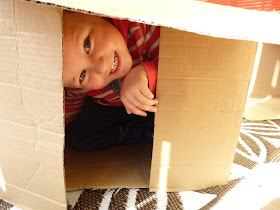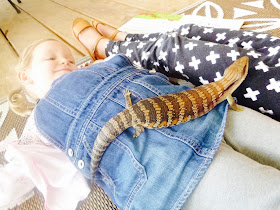Recently
when I was offered the opportunity to get a whole lot of big cardboard boxes for
kindergarten I jumped at the chance, as I have fond memories of my own children's experiences with boxes when they were young.
I thought about how much time they spent playing and exploring with
boxes, often more so with, than their other toys. When the boxes arrived you can only imagine
how excited some of our kindergarten children become when they saw them. Cardboard boxes are such a wonderful
open-ended resource and can have so many uses, only limited to their
imagination.
“Imagination is the
highest kite one can fly” Author
Unknown

To
help inspire those children who had trouble seeing something more than just a
box, I found and read our book ‘Not a box’.
For those who haven’t read ‘Not a box’ by Antoinette Portis, it has been
described as “A box is just a box….unless
it’s not a box. From mountain to rocket
ship, a small rabbit shows that a box will go as far as the imagination
allows. Inspired by a memory of sitting
in a box on her driveway with her sister, Antoinette Portis captures the thrill
when pretend feels so real that it actually becomes real – when the imagination
takes over and inside a cardboard box, a child is transported to a world where
anything is possible.”

It was certainly fabulous to sit back and watch how our children explored the boxes and what kind of play developed by only using their imaginations; some curiosity, a bit of creative thinking, some resourcefulness and sometimes working collaboratively. Before long there were many adventures happening with pirate ships heading out to sea to find treasure, trains preparing to leave the station, multi-level houses being constructed and with the addition of fabrics, cushions and pegs resulted in castles built that were fit for many princesses.
“With nothing
more than a little imagination, boxes can be transformed into forts or houses,
spaceships or submarines, castles or caves.
Inside a big cardboard box, a child is transported to a world of his or
her own, one where anything is possible.” (National
Toy Hall of Fame, 2013)

I
really had no idea where the children’s interest in the boxes would go,
however, I do know that I feel very privileged to be part of their adventures,
here are some of the children’s words while playing:
Alfie: I’m in a pirate ship, looking for
treasure. I’m a pirate, a real pirate, I
go for treasure, normally naughty pirates steal treasure!
Aya: Look we are building a box house, here’s my
bedroom, I need a sleep now. We’re
making a rainbow museum now.Kobi: Look at my giant thing for a rocket.
Mia: I love this house, can I please come in? Can I have a playdate?
Imogen: This is my room, you have to knock on my door?
Oliver: I am a robot, I am a robot. Look this is a magical box, someone is in it.
Riley S: I want it to be a big balloon.
Amelia: Oh can I help get the boxes, I love to make a house.

As I observed the children playing I soon realised there is so much learning happening, and not just what I mentioned above about children using their creativity, imaginations and resourcefulness. There is also all the physical and emotional side, with children using big muscle movements to move boxes about, spatial awareness (which box can they fit into?), finding the right size box to simply hide in and feel a sense security in a small space. Providing protected spaces is something we are passionate about at Mairtown and cardboard boxes can be transformed into another form of protected space. Research states how box play can be soothing for children, the humble cardboard box is a great example of an 'asensory' environment. The brown colour suggests nothing in particular. The smooth sides infer little. The cube structure defines empty space. The subtle smell lacks distraction. The sound of the cardboard folding is muted and music-less. This very LACK of sensory inputs (or perhaps, more accurately said, the subtle nature of the sensory inputs) is an essential contrast to the more powerful and deliberate stimulation we traditionally think of when we talk about “sensory play”. This relief from the sensory world may explain, in part, why kids find the confines of a cardboard box so appealing. And of course, it's very neutrality is the blank-slate upon which children so easily imprint their imaginations…(Cheryl McCarthy, Moving Smart, 2013).
The thing with cardboard boxes is that they don’t last forever and when they start to break down there is the added bonus of being able to put the cardboard boxes out for recycling…then there is another new layer of opportunity for our children’s learning about sustainability and the environment. It is great to see that the humble cardboard can bring so much joy, adventures and learning.
Mā te wā,
Susie












































